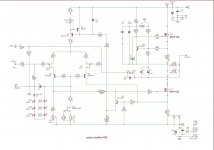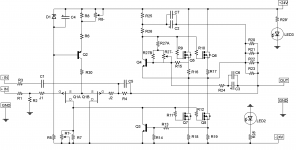Hi all here.
First off merry christmas and soon a happy newyear 🙂
While rebuilding my poweramp (F5 at moment, F6 at desk)... i was feeling that it might be a way better idea to lower the power, and going for smaller heatsinks; also i would like a smaller chassis to be honest.
I think i can get along fine with ~15Watt with my current speakers/preamp. (Speakers 90dB, Preamp DCG3 with gain X 2).
The heatsinks i have now, can "easily" blow away 200W (F5, AlephJ etc.) for a stereo setup. If i split them, i will end up with half of that approx.
So an Mini Aleph, uses around 100W for a two channel setup, which would be fine. -But when i was surfing around i also read about a mini alephJ, and mini Babelfish, -soo this could be very interessting to build i think. -I just cant seem to find good information regarding those?, also the Mini aleph is difficult to find right information about. So i would be pleased if someone here has some schematic, links, whatever about such mini amp.'s 🙂
I prefer something like mini aleph, but maybee a newer version with jfet's.
Also the babelfish mini i am very currius about!
Jesper.
EDIT : Name of thread!
First off merry christmas and soon a happy newyear 🙂
While rebuilding my poweramp (F5 at moment, F6 at desk)... i was feeling that it might be a way better idea to lower the power, and going for smaller heatsinks; also i would like a smaller chassis to be honest.
I think i can get along fine with ~15Watt with my current speakers/preamp. (Speakers 90dB, Preamp DCG3 with gain X 2).
The heatsinks i have now, can "easily" blow away 200W (F5, AlephJ etc.) for a stereo setup. If i split them, i will end up with half of that approx.
So an Mini Aleph, uses around 100W for a two channel setup, which would be fine. -But when i was surfing around i also read about a mini alephJ, and mini Babelfish, -soo this could be very interessting to build i think. -I just cant seem to find good information regarding those?, also the Mini aleph is difficult to find right information about. So i would be pleased if someone here has some schematic, links, whatever about such mini amp.'s 🙂
I prefer something like mini aleph, but maybee a newer version with jfet's.
Also the babelfish mini i am very currius about!
Jesper.
EDIT : Name of thread!
Last edited by a moderator:
Follow the link below to the original thread:
http://www.diyaudio.com/forums/pass-labs/2001-mini.html
http://www.diyaudio.com/forums/pass-labs/2001-mini.html
Hi Jesper,
I think you can modify a mini-a to use a jfet front end using the same
modification for the Aleph 3. The latter modification is shown in the
first schematics in this post:
http://www.diyaudio.com/forums/pass-labs/267857-aleph-design-reloaded.html#post4184920
Cheers,
Dennis
I think you can modify a mini-a to use a jfet front end using the same
modification for the Aleph 3. The latter modification is shown in the
first schematics in this post:
http://www.diyaudio.com/forums/pass-labs/267857-aleph-design-reloaded.html#post4184920
Cheers,
Dennis
Thanks.. all!
So this schm. Babelfish it's possible to run this at lower rail's?
Jesper.
So this schm. Babelfish it's possible to run this at lower rail's?
Jesper.
Attachments
Last edited:
as said zillion times , for any mosfet based output stage - do not use lower PSU rails than +/-15V , or you're having trouble due to increased nonlinearity of inherent mosfet capacitances
then use whatever Iq you want , but I wouldn't go lower than 1A
yes , this schmtc can be used for Mini , in which case you can skip cascodes for input JFets ...... or leave them , but with necessary change in voltage biasing
few other resistor values need to be optimized , strictly for rails and Iq one intend to use .....
then use whatever Iq you want , but I wouldn't go lower than 1A
yes , this schmtc can be used for Mini , in which case you can skip cascodes for input JFets ...... or leave them , but with necessary change in voltage biasing
few other resistor values need to be optimized , strictly for rails and Iq one intend to use .....
Anything to change if i use j176 or j103 to replace j271?Thanks.. all!
So this schm. Babelfish it's possible to run this at lower rail's?
Jesper.
In one of the Zen articles Nelson said he liked the sound of a mosfet running 40 watts (current times volts).
Last edited:
Anything to change if i use j176 or j103 to replace j271?
there is ancient pdf I made (almost 10 yrs ago) , floating as attachment in several posts here
anyway , here it is again
I remember I included J176 on list because few boyz tried it and they were satisfied ; however - I remember also funny listening tests revealing (sound) difference between various parts used in CCS above input LTP ...... where I can understand difference betewwn bad CCS and good (enough ) CCS ...... but frankly I cant grasp differene between two good (enough) ones
so , I didn't tried J176 and I have reserve about other ppl experience (see above)
disclaimer - my ZMengrish isn't much better now ,than it was then

however ,comparing to Toshibas and even to J271 , J176 is somewhat wimpy in one of most important parameters - xconductance (read-gain)
if you must use it , double it - use 2+2 in input LTP ..... all 4 matched of course at , say , 2.5mA
J103 (you asked for) was , I believe typo - you probably meant on 2SJ103 ; answer is no - xconductance is waaaay too low
Attachments
disclaimer - my ZMengrish isn't much better now ,than it was then
Considering that every now and then you have something interesting to say, I would rather read it in ZMengrish than not at all.

as said zillion times , for any mosfet based output stage - do not use lower PSU rails than +/-15V , or you're having trouble due to increased nonlinearity of inherent mosfet capacitances
then use whatever Iq you want , but I wouldn't go lower than 1A
yes , this schmtc can be used for Mini , in which case you can skip cascodes for input JFets ...... or leave them , but with necessary change in voltage biasing
few other resistor values need to be optimized , strictly for rails and Iq one intend to use .....
Also what's written, due to cascoding rail can be lower.
Anyway, if used with 2 pcs. irfp240's running with normal Pass rails 😀 (2x23vdc).. how much dissapation must i expect?
Jesper.
Also what's written, due to cascoding rail can be lower.
Anyway, if used with 2 pcs. irfp240's running with normal Pass rails 😀 (2x23vdc).. how much dissapation must i expect?
Jesper.
due to cascoding , rail voltage can be higher
that was at least one reason why cascoding at all
dissipation , P=U x I
I found this.
Maybee with 17v rails it could be good?
Looks interessting i think!
Jesper.
sch is incomplete (missing values)
as I said - take any Aleph schematic , change few resistor values (decrease Iq and rails accommodation) and that's it
due to cascoding , rail voltage can be higher
that was at least one reason why cascoding at all
dissipation , P=U x I
sch is incomplete (missing values)
as I said - take any Aleph schematic , change few resistor values (decrease Iq and rails accommodation) and that's it
Yep; I kindoff understand this, but if we compare the attachment i posted before i see that there is only two mosfets, instead of four which exsist in original AlephJ sch. (attached here)
So i throught (also what i read) that an "mini" Aleph, is both lower voltage rail,s and less output devices?
Am i right ?
Jesper.
Attachments
pretty simple and effective logic was used in making entire Aleph series - starting from lower rails and dissipation , going to higher rails and dissipation , resulting in broad span of power figures
taking in account that there is sane limit for dissipation per mosfet , it's logical to multiply pairs as needed for particular amp
anyway , as i remember , idea for Mini Aleph came from aspirations to make one in smaller form factor , same as to find use of some leftover parts (smaller heatsinks , smaller xformer)
later , term Mini is stretched to absurd - I remember seeing amps in same dissipation range as Aleph 3 (30) , called Mini
so , make up your mind , decide what you need ...... and ask exact question
this is post #16 , and we just tackled meaning of amp's name
taking in account that there is sane limit for dissipation per mosfet , it's logical to multiply pairs as needed for particular amp
anyway , as i remember , idea for Mini Aleph came from aspirations to make one in smaller form factor , same as to find use of some leftover parts (smaller heatsinks , smaller xformer)
later , term Mini is stretched to absurd - I remember seeing amps in same dissipation range as Aleph 3 (30) , called Mini
so , make up your mind , decide what you need ...... and ask exact question
this is post #16 , and we just tackled meaning of amp's name

pretty simple and effective logic was used in making entire Aleph series - starting from lower rails and dissipation , going to higher rails and dissipation , resulting in broad span of power figures
taking in account that there is sane limit for dissipation per mosfet , it's logical to multiply pairs as needed for particular amp
anyway , as i remember , idea for Mini Aleph came from aspirations to make one in smaller form factor , same as to find use of some leftover parts (smaller heatsinks , smaller xformer)
later , term Mini is stretched to absurd - I remember seeing amps in same dissipation range as Aleph 3 (30) , called Mini
so , make up your mind , decide what you need ...... and ask exact question
this is post #16 , and we just tackled meaning of amp's name
I wrote in first post 100w dissipations for stereo.
Thanks...
Jesper
use 2x15Vac xformer , resulting in 18Vdc rails
set iq to 1A2 or something like that
use one pair of IRFP240
choose pcbs of your liking (any Aleph type) , post here what's your choice and exact schematic for that pcb and I'll wrote what to change for your needs
set iq to 1A2 or something like that
use one pair of IRFP240
choose pcbs of your liking (any Aleph type) , post here what's your choice and exact schematic for that pcb and I'll wrote what to change for your needs
ZM, it's very kind of you to offer your expertise.
I'm curious that with lower rails (say 18V), is there any advantage in using lower voltage/higher
transconductance parts like IRFP140 or IRFP044?
Thanks,
Dennis
I'm curious that with lower rails (say 18V), is there any advantage in using lower voltage/higher
transconductance parts like IRFP140 or IRFP044?
Thanks,
Dennis
why not
ppl already done that
most important thing Papa gave us is zillion of puzzles/legos and recipe use your brain and play
ppl already done that
most important thing Papa gave us is zillion of puzzles/legos and recipe use your brain and play
- Status
- Not open for further replies.
- Home
- Amplifiers
- Pass Labs
- AlephJ Mimi! (Mini)

